

| How To Avoid Nearsightedness
|
Truth is so obscure in these times,
and falsehood so established,
That unless we love the truth
we cannot know it. - Blaise Pascal
Over the past eighty years, eye doctors have become increasingly suspicious of negative-lens use for nearsightedness. While the immediate effect is instant clarity of vision, the long-term effect has been recognized to be bad. For instance Dr. Samuel Drucker said: (3)
The suspicion began to dawn on me slowly that among the causes of progressive myopia it might be necessary to list concave lenses themselves. From many articles that have appeared in the past on the subject of 'Optical Poison', a familiar term a decade (1930) ago, many other optometrists appear to have the same idea.
An optometrist in Ontario (1938) says that, "...he would like to have a law established and enforced that would make it a misdemeanor for any refractionist (optometrist) to prescribe minus glasses for any child unless under very extenuating circumstances." (3)
These are strong opinions by individuals who have had direct and prolonged experience with the use of a negative lens and the effect that this lens has on the normal eye.
Doctors, some time ago, have correctly deduced the nature of the problem and suggested the correct solution. For example, Chalmers Prentice, wrote the following in 1895: (3)
In the nomad, who is reared out of doors, and who follows such pursuits that his vision is mostly used at twenty feet and greater distances, the nerve-impulses to the ciliary (lens) muscle become established so that the easiest vision is for the far point, and in many years of such use, these impulses become more or less fixed; while the child of a higher civilization spends his life within doors, amuses himself with toys, picture books, kindergarten amusements and learning to read.
We will assume that such a child generally holds his book or toy 10 inches (4 diopters) from his eyes, in which case the crystalline lens requires a much greater convexity, or higher state of refraction to bring about perfect vision; and this is brought about by an increase in the ciliary nerve-impulse which changes the shape of the ciliary lens. Through long continued use, this impulse becomes comparatively fixed, and in some instances refuses to suspend itself sufficiently to bring about distant vision again, and so myopia has set in. The regular work of the student and those other pursuits which require the use of the eye at the near point, tend to perpetuate this condition and make it progressive.
...Again, the important question, 'How are the advantages of a high civilization to be attained without the foregoing disadvantages?' If the eyes are to be used at a distance of ten inches, aid them artificially by a ten inch magnifying glass; then the nerve-impulses to the ciliary muscle will be no more than if the patient were leading an outdoor life and viewing objects at twenty feet or more.
It is clear that the collective common sense of the profession has indicated the type of problem they face and the nature of the expected solution. In the article "Trying to Get Myopia into Focus", (1987) Dr. Theodore Grosvenor of the Houston College of Optometry, insists that persistent close work causes myopia. He also states that; "Once the eye has started to stretch, it may be too late to keep it from stretching. The ultimate study would be to put reading glasses on first-graders, before anyone has developed myopia." (4)
With this type of scientific understanding of the eye's behavior, you would think that the insightful and motivated optometrist or ophthalmologist could introduce a practical and effective method of solution. Dr. Jacob Raphaelson did exactly that in the following example -- with the following result:
"It was the year 1904 that I met a mother at a social lodge meeting. She told me about her son's trouble with his eyes in school. I gave her my card and told her to bring him to my office and I would fit him with a pair of spectacles.
"She said that she had no money at the time and that her husband was a printer working in another city. She did not expect him home for the next six weeks. I told her all this would not matter, that she should bring the boy over and I would fit him with a pair of spectacles. I told her that she could pay for them when her husband returned home.
"She brought the boy in and I examined his eyes. I found that his vision for distance was poor. It was less than 20/40. I made him a pair of plus 1.00 diopter spectacles. She was to pay me when her husband came back home.
"In about six weeks she came back and returned the glasses to me. She stated that her husband was provoked with her for getting the glasses. He had tried the boy's eyes with different prints, far and near, and had found him to have perfect vision with his naked eyes. In fact, she said, the boy could see even better without the glasses than with them.
"I was surprised that the plus lens could produce recovery that quickly. I could hardly believe this story. I persuaded the mother to bring the boy back to let me check to see if he could really see well with his naked eyes. She again brought the boy in and I checked his vision. I found that the father was indeed right. The boy had good eyes, with 20/20 vision and better.
"I was in a dilemma. I did not have the nerve to say anything to the mother. I just let her go. How was I to prove that the boy had poor vision before he received his glasses? And who would believe that vision could be restored by just wearing a pair of plus 1.00 glasses for a few weeks?
"My experience with the printer's son aroused my inborn tendency for exploration. It gave me an incentive to try to do special work on children's eyes and on vision restoration. It also enticed me to investigate myopic (nearsighted) eyes because I was myself nearsighted.
"On the other hand, this experience was a warning to be cautious in doing such work. For selling spectacles to persons who, supposedly, did not need them was almost a crime. And the fitting of glasses without the advice or consent of a medical doctor to unhealthy or diseased eyes, or even to an unhealthy person who might need or be under medical attention, was, and is now, and encroachment on the medical profession.
"To shield myself against possible enmity and involvement, I took the following precautions: First, I quit using the title 'doctor' in any form, in print or verbally. I was to be known as a spectacle fitter and nothing more. Second, I charged a reasonable price for the spectacles I sold but nothing extra for any special work or relief I gave. I did not advertise about this special work. I just did it as a matter of routine whenever or wherever I was given the opportunity.
"Thus in 1904 I became an independent researcher on the relationship of the eye's behavior to spectacles, vision, and health. I have kept it up, and will continue to do this work as long as I continue to have the incentive and capability.
"Who would believe it? Who would believe that by just wearing a pair of plus one (+1.00) glasses for a few weeks, that normal vision to the naked eye could be restored to children whose eyes have a negative focal state? This was true in 1904, and it is also true now, in this decade of 1950." (It continues to be true in this decade of 1990 -- Otis Brown)
With such strong recognition that a negative lens has such a profound and adverse effect, you would think that it should be possible to develop scientific verification for this characteristic of the normal eye. You would be correct. The testing and verification is impeccable -- if we restrict our attention to the normal eye's behavior.
In order to understand the design and behavior of the normal eye it is necessary to understand its basic optical properties.
When a light ray enters water it is refracted (bent). The equation that describes this bending is shown below. Water has an Index-of-Refraction of 1.33. The normal eye has 1.38 as an over-all Index-of-Refraction. (Figure 1)
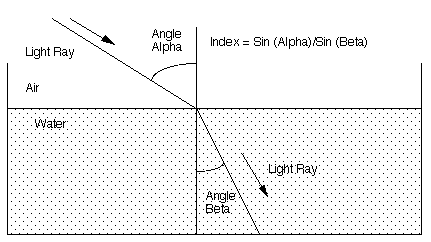
Figure 1.
When light travels through a curved surface, the light rays converge on a single point. Since an image is made up of a large number of points of light, an image will form where the light rays converge. (Figure 2)
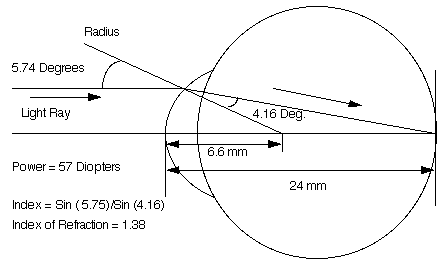
Figure 2 (from Gullstrand's schematic eye, Reference 1).
The distance between the surface of the lens and the point of image formation is called the focal length.
Focal Power = (Refractive Index) / (Focal Length)
By using this equation it is possible to analyze the basic optical properties of the eye. The approximate dimensions of the eye have been established. The radius of the cornea is 0.66 centimeters, the index of refraction is 1.38, and the length of the eye is 2.4 centimeters. By using these numbers we can calculate the focal power of the normal eye. (For reasons of clarity, I have not included the effect of the internal lens. A more detailed analysis can be found in Reference 1.)
Focal Power = 1.38 / .024 Meters
Focal Power = 57 Diopters
The eye has an internal lens which controls the short-term focal state of the eye. The lens is controlled by blur sensed at the surface of the retina. This information is "fed back" to lens position so that sharp focus can be maintained. (Figure 3)
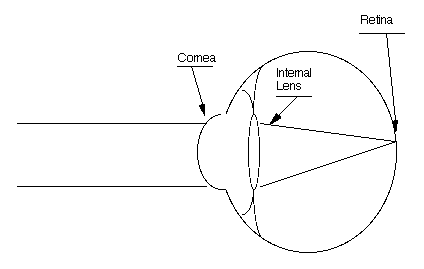
Figure 3.
As objects are moved from distance to near, blur is produced at the retina. In response to this, the lens is thinned or thickened repeatedly under neurological/muscular control, thus maintaining sharp focus on the retina. (Figure 4)
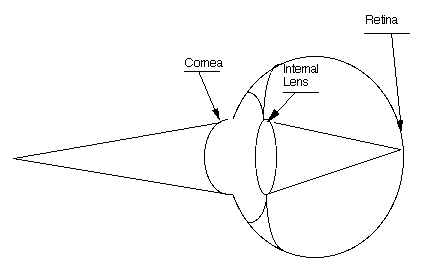
Figure 4.
As we move objects from far to near, the focal change required of the eye increases drastically. Thus the focal change required for an object at 1 yard is 1 diopter. At 20 inches the increase in power is 2 diopters, and at 10 inches the increase is 4 diopters.
The normal eye has a second system which is responsible for controlling its long-term focal state. This system controls both the power (curvature) of the cornea and the relative length of the eye. (Figure 5)
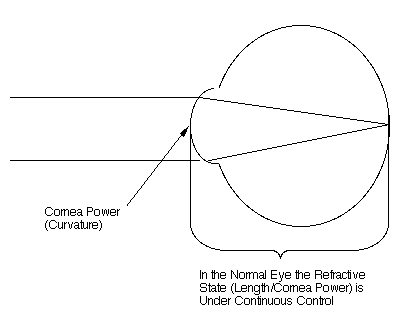
Figure 5.
The normal eye feeds information from the accommodation system to the long- term control system to maintain highly accurate focus. The focal state of the eye is almost a direct replica of its visual environment. By direct experimental means it has been determined that the focal state of the normal eye is equal to its visual environment, offset by about +1.5 diopters.
Whenever the average value of accommodation is shifted by a "delta", the focal status of the normal eye will change, (over a period of months) by the same quantitative amount. This statement has been effectively proven over the last thirty years by thorough experimental techniques. (2)
As the previous discussions have demonstrated, the eye functions as a camera. We should not, however, jump to the conclusion that it is therefore a rigid box camera. It is a sophisticated camera that controls its long-term focus by a "feedback" process. We can use an analog computer to accurately represent this fundamental behavior characteristic of the eye. (Figure 6)
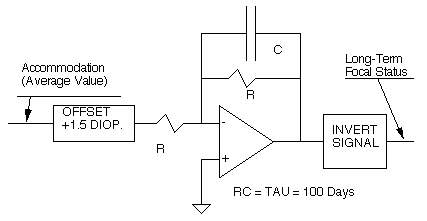
Figure 6.
The above representation of the normal eye is experimentally valid. When the normal eye is actually tested, it always shows the following two major behavior characteristics. (2)
1. When a strong negative change is made in your visual environment, your normal eyes will change their focal state as shown below. (Figure 7)
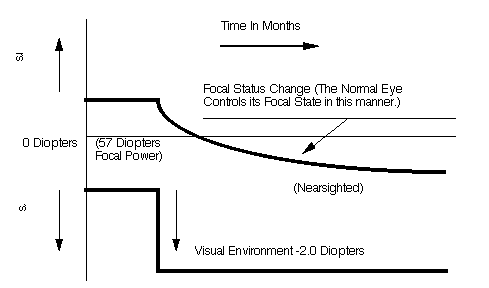
Figure 7.
2. The eye will also show a similar response to a strong positive = change in its environment. There is -- and this is important -- a limit to = the amount by which you can change your visual environment in a positive direction. (Figure 8)
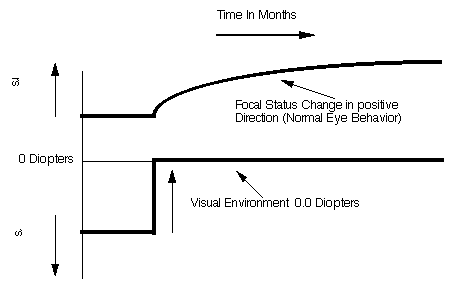
Figure 8.
The conclusion, that the eye is dynamic and behaves as expected, has been reached by a number of scientists. Dr. Peter Greene (5), Dr. Antonio Medina (6), and Dr. Josh Wallman (7) have published papers analyzing various aspects of the time-constant behavior of the natural eye.
Perhaps the best assessment of the difficulties and opportunities of nearsightedness prevention was made by Chalmers Prentice in 1895. How many more years will it take us to understand and respond intelligently to the wisdom in his words?
It is common and natural to cling to a belief in things and methods that have long been established, and in which leading men and authors concur; and, if the results of such following are universally perfect, more cannot be desired. But, when they fall far short of satisfaction, we are warranted and even impelled to search outside of established authority for the aid that it fails to give; otherwise, science and art would never advance.
1. Southall, J. P. C., "Introduction to Physiological Optics", Dover Publications, Inc., pp 46, (1937)
2. Schaeffel., F. Glasser, A. Howland, H. C., "Accommodation, Refractive Error and Eye Growth in Chickens", Vision Res., Vol 28, No 5, pp. 639-657 (1988)
3. Raphaelson, J., "A Preventative and Remedy for School-Myopia", Research Foundation for Prevention of Myopia, Inc. pp 60 (1958)
4. Holzman, D., "Trying to Get Myopia Into Focus", Health, pp 52-53, (Feb. 1987)
5. Greene, P. R. & Guyton, D. L., "Time Course of Rhesus Lid-Suture Myopia", Exp. Eye Res., V 42, p. 529-534, (1986)
6. Medina, A. & Fariza, E., "Emmetropization as a First-Order Feedback System", Vis. Res., V. 33, No. 1, p. 21-26, (1993)
7. Wallman, J. Turkel, J., Trachtman, J., "Extreme Myopia Produced by Modest Change in Early Visual Experience", Science, V. 201, p. 1249-1251, (Sept. 1978)